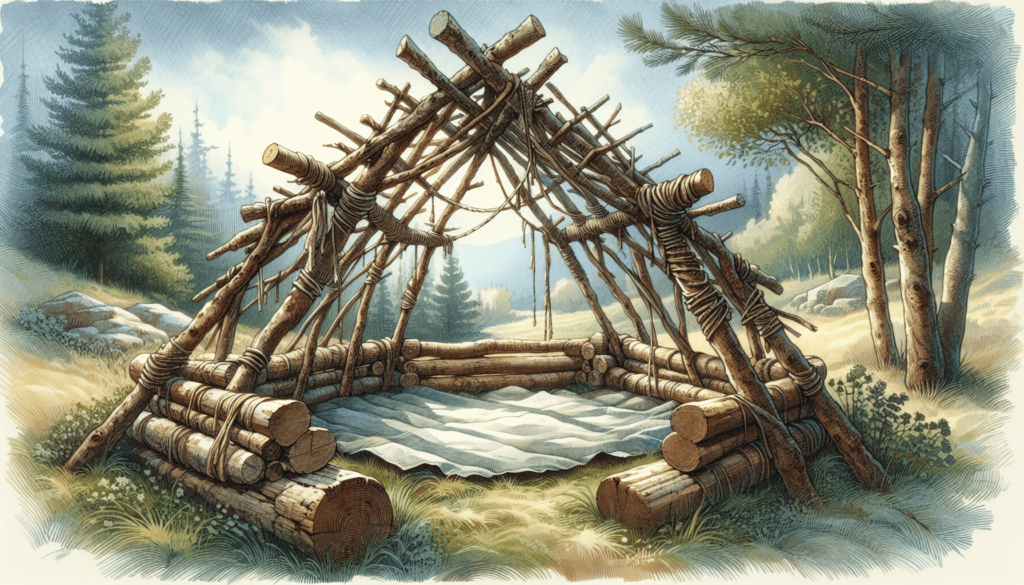Have you ever been out in the open and felt the chilling wind cut through your clothes, making you wish for just a little more shelter? Learning how to make a windbreak shelter can transform your outdoor experience, providing much-needed protection against the elements. In this article, you’ll discover step-by-step instructions and useful tips to construct your own windbreak shelter, ensuring you stay warm and comfortable during your outdoor adventures.

Why Build a Windbreak Shelter?
A windbreak shelter is an essential skill for anyone who spends time outdoors, whether you’re hiking, camping, hunting, or just enjoying nature. The primary purpose of a windbreak is to reduce wind speed, which in turn minimizes the chilling effect on your body. A well-constructed windbreak not only keeps you warm but also conserves your energy, making your outdoor activities more enjoyable and less exhausting.
The Benefits of a Windbreak Shelter
Protection from Weather
One of the most significant benefits of a windbreak shelter is protection from harsh weather conditions. Wind gusts can quickly sap your body heat, leading to hypothermia in extreme cases. A windbreak shelter acts as a barrier, reducing wind chill and keeping you comfortable.
Increased Comfort
By creating a calm area behind the windbreak, you can cook, rest, or set up camp with greater ease. The shelter also provides a sense of security and coziness, making your outdoor experience much more pleasant.
Energy Conservation
Fighting against the wind takes a considerable amount of energy. By constructing a windbreak shelter, you conserve your energy and reduce fatigue, allowing you to enjoy your activities longer and more fully.
Essential Materials and Tools
Before you start building your windbreak shelter, it’s crucial to gather all the necessary materials and tools. Having everything on hand will make the process smoother and more efficient.
Materials
| Material | Description |
|---|---|
| Stakes/Poles | Use sturdy, durable stakes or poles to support your shelter. |
| Tarpaulin/Canvas | A strong, weather-resistant cover for your windbreak. |
| Ropes or Bungee Cords | For securing the tarpaulin to the stakes or poles. |
| Natural Materials | Branches, leaves, and other natural elements for added insulation and support. |
Tools
| Tool | Description |
|---|---|
| Hammer or Mallet | For driving stakes into the ground. |
| Knife or Scissors | To cut ropes or canvas. |
| Spade or Shovel | For digging and leveling the ground. |
Step-by-Step Guide to Building a Windbreak Shelter
Now that you have your materials and tools ready, it’s time to start building your windbreak shelter. Follow these steps for a reliable and effective windbreak.
Step 1: Choose the Right Location
Selecting the appropriate location for your windbreak shelter is critical. Look for a site that is naturally protected from the wind, such as behind a hill, large rock, or dense group of trees. This will reduce the overall wind speed and enhance the effectiveness of your shelter.
Step 2: Assess Wind Direction
Understanding the wind direction is essential. You want your shelter to block the wind as much as possible, so position it perpendicular to the prevailing wind. Use natural indicators like tree bends and grass movement to determine the wind direction.
Step 3: Clear the Area
Remove any debris, rocks, or vegetation from the area where you plan to build your shelter. This will give you a clean, level surface to work on and ensure that your windbreak is stable and secure.
Step 4: Drive the Stakes or Poles
Using your hammer or mallet, drive the stakes or poles into the ground at regular intervals. These will support your tarpaulin or canvas. The spacing will depend on the size of your shelter, but a good rule of thumb is to place them about 3-4 feet apart.
Step 5: Attach the Tarpaulin
Once your stakes are in place, secure the tarpaulin or canvas to the stakes using ropes or bungee cords. Make sure the cover is taut and secure to prevent it from flapping in the wind. You can use a knot, such as a trucker’s hitch, for added stability.
Step 6: Add Natural Materials
For extra insulation and stability, you can add natural materials like branches, leaves, or grasses to your windbreak. Pile them up against the tarpaulin to create an additional layer that will help block the wind and keep your shelter warmer.
Step 7: Secure the Bottom Edge
Finally, secure the bottom edge of the tarpaulin to the ground using rocks, logs, or additional stakes. This will prevent wind from slipping underneath the tarpaulin and provide a more effective barrier.
Types of Windbreak Shelters
There are several types of windbreak shelters you can construct, each with its unique benefits and considerations. Here are a few common types to consider based on your specific needs and available materials.
Basic A-Frame Windbreak Shelter
An A-frame windbreak is a simple yet effective design that provides a stable barrier against the wind. It is easy to set up and works well in various environments.
How to Build an A-Frame Windbreak
- Drive two stakes into the ground to form the apex of the A-frame.
- Drive additional stakes at regular intervals to form the base of the frame.
- Drape the tarpaulin over the stakes, securing it at the apex and the base.
- Secure the bottom edges with rocks or logs for added stability.
Lean-To Windbreak Shelter
A lean-to windbreak is a versatile and straightforward design that provides excellent protection against the wind. It is particularly useful when you have a natural structure to lean against, such as a tree or a large rock.
How to Build a Lean-To Windbreak
- Choose a natural structure to lean your shelter against.
- Drive the stakes into the ground at regular intervals to support the tarpaulin.
- Attach the tarpaulin to the stakes and the natural structure, creating a sloped surface.
- Secure the bottom edges with rocks or logs for added stability.
U-Shaped Windbreak Shelter
A U-shaped windbreak provides more comprehensive coverage by blocking wind from multiple directions. This design is particularly useful in open areas where wind can come from various angles.
How to Build a U-Shaped Windbreak
- Drive stakes into the ground to form a U-shape, with one open end facing away from the wind.
- Attach the tarpaulin to the stakes, creating a barrier along the three sides of the U-shape.
- Secure the bottom edges with rocks or logs for added stability.

Tips for Enhancing Your Windbreak Shelter
Building a windbreak shelter is just the beginning. Here are some additional tips to maximize the effectiveness of your shelter and enhance your outdoor experience.
Use Natural Features to Your Advantage
Whenever possible, use natural features like hills, rocks, and dense vegetation to complement your windbreak. These features can provide additional protection and reduce the amount of work required to build your shelter.
Insulate with Natural Materials
Adding layers of natural materials like leaves, branches, and grasses can significantly improve the insulation of your shelter. This helps to trap heat and create a more comfortable environment inside.
Secure Your Shelter Against Strong Winds
In areas with strong or variable winds, it’s essential to ensure that your shelter is well-secured. Use additional stakes, rocks, or logs to anchor the tarpaulin and prevent it from being blown away.
Maintain and Adjust as Needed
Regularly check your shelter for any signs of wear or damage, especially after a storm or strong winds. Make any necessary adjustments to keep your shelter in good condition and ensure it continues to provide effective protection.
Environmental Considerations
When building a windbreak shelter, it’s essential to consider the environmental impact of your actions. Here are some guidelines to help you minimize your impact and leave no trace.
Use Sustainable Materials
Whenever possible, use sustainable and environmentally-friendly materials for your shelter. Avoid using materials that could harm the environment or leave a lasting impact.
Leave No Trace
When you leave the area, dismantle your shelter and return the site to its natural state. Dispose of any waste properly and ensure that you leave no trace of your presence.
Respect Local Wildlife
Be mindful of local wildlife when choosing your shelter location and gathering natural materials. Avoid disturbing habitats or causing harm to the environment.
Troubleshooting Common Issues
Even with careful planning and execution, you may encounter some common issues when building a windbreak shelter. Here are some solutions to help you troubleshoot and overcome these challenges.
Tarpaulin Flapping in the Wind
If your tarpaulin is flapping in the wind, it may not be taut enough or securely anchored. Check the tension of the tarpaulin and add additional stakes, ropes, or bungee cords as needed to keep it in place.
Shelter Collapsing
A collapsing shelter is often due to insufficient support or poor anchoring. Ensure that your stakes are driven firmly into the ground and that the tarpaulin is securely attached. Adding additional support with natural materials can also help stabilize the shelter.
Insufficient Wind Protection
If your shelter is not providing adequate wind protection, consider adjusting its orientation to better block the wind. You may also need to add more layers of natural materials for added insulation and stability.
Conclusion
Building a windbreak shelter is a valuable skill that can greatly enhance your outdoor experience. With the right materials, tools, and techniques, you can create a reliable and effective barrier against the wind, keeping you warm, comfortable, and safe. Remember to consider the environment, use natural features to your advantage, and regularly maintain your shelter for the best results.
Whether you’re an experienced outdoor enthusiast or a casual nature lover, knowing how to build a windbreak shelter will ensure you stay protected and enjoy your time in the great outdoors to the fullest.

